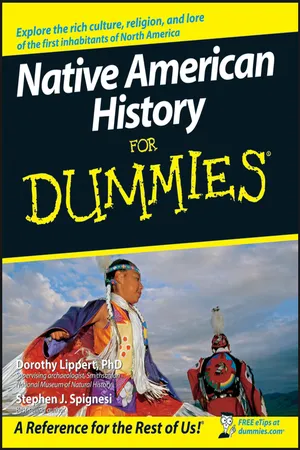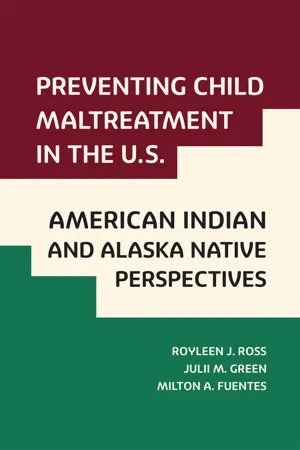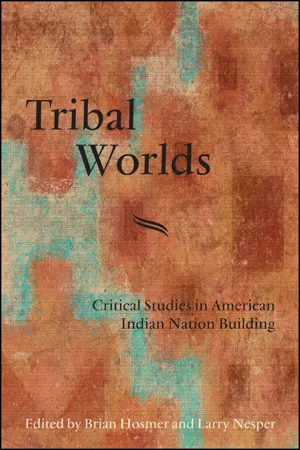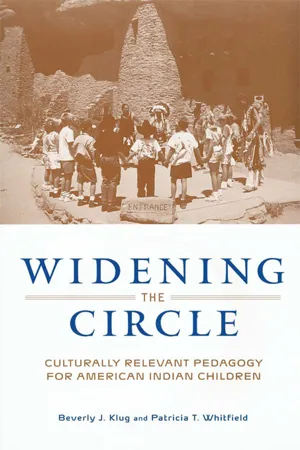History
Native American Society
Native American society refers to the diverse cultures, traditions, and social structures of the indigenous peoples of North and South America prior to European colonization. These societies were often organized around kinship, with distinct languages, belief systems, and ways of life. They had complex social, political, and economic systems, and their interactions with European settlers significantly impacted their way of life.
Written by Perlego with AI-assistance
Related key terms
5 Key excerpts on "Native American Society"
- eBook - ePub
- Dorothy Lippert, Stephen J. Spignesi(Authors)
- 2011(Publication Date)
- For Dummies(Publisher)
And at the very same time in that year 2000, there were cultures and societies on earth that were living, in a sense, in the future: They had unrestricted 24-hour electricity, water and sewage needs taken for granted, food of all kinds and varieties everywhere, advanced medical care a phone call away, wireless communications, Internet access.The one constant regardless of a culture’s stage of development, though, has always been the family and, on a larger scale, community. This fact always was, and still is, the guiding principle for American Indians.Indians have many familial and societal constructs, with family always being the core of their society. In this chapter we look at these various forms of Native American community, particularly tribes, clans, and bands.Coming to Terms in Indian Society
When talking about Indian society, it is important to remember that tribes are both political and cultural units. A tribe can be split into different groups, all of which are recognized as independent nations by the federal government. Within a tribe, there may be smaller groupings according to an individual’s lineage or religious affiliation. Some tribes have religious societies and some have clans that are usually based on family relationships.The tribes that are recognized as sovereign entities by the U.S. government are labeled as tribes or bands. In the case of Alaska, historical circumstances have meant that what might have been construed as a tribe in the lower 48 are instead incorporated as “Native Villages.” These villages have the same authority as tribes, but what would have been a tribe farther south may be spread throughout several villages.Clans exist among some tribes and a person belongs to a specific clan based on their family relationship. For some tribes, clans that existed in the past are no longer recognized because that information was lost during removal. Other tribes that were able to remain in their traditional territory continue to maintain strong clans. - eBook - ePub
Advanced Educational Foundations for Teachers
The History, Philosophy, and Culture of Schooling
- Donald K. Sharpes(Author)
- 2013(Publication Date)
- Routledge(Publisher)
12.Native Americans and EducationOverview
Native Americans or American Indians, living in isolated pockets throughout the United States, have maintained a culture that is rapidly disappearing among some of the 550 American Indian tribes in the continental United States. Some archaeologists contend that Native peoples in all of North and South America, walking across the ice and/or land bridge that once connected Asia and Alaska, are descendants of Asians from about 40,000 years ago.Although Native Americans constitute less than 1 percent of the population of the United States, they are a very significant part of America’s history, cultural survivors of a time when Americans need to learn the craft and art of survival in the third millennium. The search for the identity of the Native American is, in part, the search for a composite American identity. Schools are at the focal point of that American tradition of finding familial and ancestral roots.This chapter explores both the educational and cultural roots of American Indians, highlighting a few of the historical events and key figures in American Indian history in the last few hundred years.Key Questions
- What have the Native American peoples contributed to American life?
- What forms of discrimination have both the Asian and Native Americans endured from the dominant majority in society?
Important Terms
- primogeniture
- Indian Education Act (1972)
- sweat lodge
- Northwest Ordinance of 1787
- Bureau of Indian Affairs
- Johnson-O’Malley Act (1934)
- petroglyphs
Native American History and Culture
Native Americans In American History
That the said Indians be well Secured and defended in their persons goods and properties against all hurts and injuries of the English, and that upon any breach or violation hereof, that the aggrieved Indians doe repair and address themselves to the Govem’r as the Iawes of England or this country permit, they owning themselves to be under the Allegiance of his most sacred Majestic. (Treaty between Virginia and the Indians, 1677) - eBook - ePub
Preventing Child Maltreatment in the U.S.
American Indian and Alaska Native Perspectives
- Royleen J Ross, Julii M Green, Milton A Fuentes(Authors)
- 2022(Publication Date)
- Rutgers University Press(Publisher)
1 Understanding American Indian and Alaska Native Families from the Precolonial and Contemporary ContextAt one point, if you drew a circle, the medicine people were Aboriginal, the medicine was Aboriginal, nurses, teachers were Aboriginal. But as colonization evolved and you looked at the circle, there were no Aboriginals.—Chief Robert JosephIn consideration of contextualizing the history of the United States Indigenous Nations, there is no comprehensive, verifiable, and mutually agreed upon documentation of Native American history. The majority of tribes had no written language; thus, Our histories were kept through the oral tradition, which we realize often produces variable perceptions of Our past(s). With that said, the portrayal the authors present coalesces some general concepts and remembrances as articulated by a collection of respected elder Native scholars and traditional men and women who are recognized as credible resources. In addition, we rely heavily on Native scholarly books, articles, and manuscripts to maintain the authenticity of Our voices, historically and contemporarily. These purposeful efforts seek to gather and articulate a general understanding of how American Indian/Alaska Native children were raised, the roles of women, and how those intersections counter violence and historical trauma.Collectivistic Cultural Orientation
Traditional American Indian and Alaska Native (AI/AN) family structures are generally extended-family-based and collectivistic in orientation. According to Dr. D. Subia Bigfoot, AI/AN “families come from traditionally honor based and respectful societies” (personal communication, April 5, 2018). Romero-Little et al. (2014), referring to a southwest Indigenous population, stated, “Collectivistic values are manifested in cultural constructs and in cultural approaches to socializing their children” (p. 164). Etok, an Alaska Native (AN), simply stated, “We have an inner confidence.… It is due to our close family ties and community life” (Gallagher, 2001, p. 39). In speaking about Native students, Pewewardy (2002) observed that AI/AN students endorse specific cultural principles including but not limited to the following: strong tribal society hierarchy, reticence, conformity to authority and respect for elders, patrimonial, matrilineal clans, and an emphasis on learning that is embedded in the teachings of the elders. In addition, Gregory Cajete, a Native science educator, reported in 1994 that geographical areas are fundamental to AI/AN identity and knowledge-based systems and are entrenched in reciprocal relationships within their surrounding environments (Cajete, 2016). Swisher and Tippeconnic (1999) found that Native people tend to have a holistic worldview where the intertwined parts of relationships are important to understanding the whole. These narratives from Indigenous tribal members and scholars encapsulate the Native way of life and illuminate the traditional support system, which continues to perpetuate Our existence in this ever-changing world. - eBook - ePub
Tribal Worlds
Critical Studies in American Indian Nation Building
- Brian Hosmer, Larry Nesper, Brian Hosmer, Larry Nesper(Authors)
- 2013(Publication Date)
- SUNY Press(Publisher)
63 Avoiding categorization benefited non-state peoples and aided them in asserting autonomy. While they resisted the categories of the colonizers, they were able to continue to order their own world. Retaining social, political, and cultural categories today remains a way that Indigenous people continue to assert sovereignty.Imagining tribal nations as culturally unitary, socially connected by political institutions, and spatially defined by rigid geopolitical boundaries clearly fails in its simplicity. To conceive of Native group identity in terms of the Western nation-state denies the people an intellectual sovereignty to exist as a nation on completely different terms. Although imagining tribes as emerging from specific political and historical circumstances might explain shifting sociopolitical institutions within non-state groups over time, it does not account for the durability of entire sociocultural entities that asserted continuous political autonomy. The Cheyenne existed as a group despite migrations from the Great Lakes to the Plains and the incorporation of outside bands and individuals. For this to be possible, this Native nation must have relied on something other than the maintenance of rigid social and political boundaries. To understand the ways that such flexible groups asserted a sense of sovereignty, scholars must move beyond bounded, evolutionary constructions of social organization to explore how Native self-definition of group identity differed from that of the nation-state. We also must explore where American Indian sovereignty was located historically, how it was defined, and how people utilized earlier expressions of sovereignty when faced with involuntary engagement with the nation-state. The realization that state-based constructions of tribal nations have misrepresented the historical sociopolitical organization of American Indian peoples calls for the development of an understanding of American Indian sovereign communal organization that more accurately reflects an indigenous understanding. The idea of Native nationhood allows for flexible political expression that does not deteriorate earlier political formations and hence provides a deeper understanding of the ways that Native people were able to retain sovereignty on their own terms in the face of the violent encroachment of the nation-state. - eBook - ePub
Widening the Circle
Culturally Relevant Pedagogy for American Indian Children
- Beverly J. Klug, Patricia T. Whitfield(Authors)
- 2012(Publication Date)
- Routledge(Publisher)
When you ask parents, grandparents, or other members of the community to participate in school activities, you reinforce the idea that the school is part of the community. You as a teacher are also a member of the community. You want to learn about the community and the resources available to you and your students. Native peoples are generous with their resources, and they want to be able to make an impact on future generations. Oral storytelling, teaching traditional arts and crafts, having elders speak to the students about local history, presenting information to children about jobs in the community, tutoring students, or being chaperons for field trips are just some of the ways community members can participate in schools.Through monies allotted to tribal Nations, most Nations now have their own tribal museums where artifacts are displayed. Children need to visit these museums in order to appreciate the accomplishments of their ancestors and to understand their own places in the continuance of their tribal traditions.Life Roles and Politics.Anyone with experience in politics understands how rancorous political bodies can become. Therefore, it should not come as a surprise that reservation politics might reflect local, state, and national politics. An important difference with regard to Indian Nations is the traditional role of women in tribal governments. While other American women have entered the world of politics only in relatively recent history, Native women had full enfranchisement within their Nations until the era of colonization (Ackerman, 1995, 1996). While not all women held political offices, all had powerful influences on decisions made for the welfare of their tribal Nations (Niethammer, 1977; Allen, 1989).Missionaries found it was hard to convert members of different tribes because they had to convince them of the “true path” of division of labor between the sexes. The European view of women as caretakers of the home and children and of men as being responsible for the livelihood of the family was counter to many Native practices. Hunting was considered a man's world for the most part, with women providing an equal share of food through farming or gathering activities. Farming was women's work, and the missionaries had a hard time convincing men they should become agriculturalists. Women who had played active political roles were now excluded from this process as European men insisted on contracting only with male members of the Nations (Wax, 1971).
Index pages curate the most relevant extracts from our library of academic textbooks. They’ve been created using an in-house natural language model (NLM), each adding context and meaning to key research topics.




